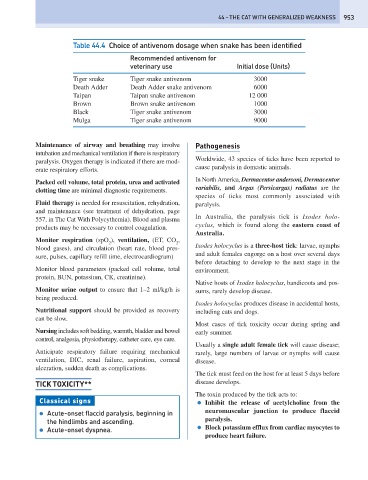Page 961 - Problem-Based Feline Medicine
P. 961
44 – THE CAT WITH GENERALIZED WEAKNESS 953
Table 44.4 Choice of antivenom dosage when snake has been identified
Recommended antivenom for
veterinary use Initial dose (Units)
Tiger snake Tiger snake antivenom 3000
Death Adder Death Adder snake antivenom 6000
Taipan Taipan snake antivenom 12 000
Brown Brown snake antivenom 1000
Black Tiger snake antivenom 3000
Mulga Tiger snake antivenom 9000
Maintenance of airway and breathing may involve Pathogenesis
intubation and mechanical ventilation if there is respiratory
Worldwide, 43 species of ticks have been reported to
paralysis. Oxygen therapy is indicated if there are mod-
cause paralysis in domestic animals.
erate respiratory efforts.
In North America, Dermacentor andersoni, Dermacentor
Packed cell volume, total protein, urea and activated
variabilis, and Argas (Persicargas) radiatus are the
clotting time are minimal diagnostic requirements.
species of ticks most commonly associated with
Fluid therapy is needed for resuscitation, rehydration, paralysis.
and maintenance (see treatment of dehydration, page
In Australia, the paralysis tick is Ixodes holo-
557, in The Cat With Polycythemia). Blood and plasma
cyclus, which is found along the eastern coast of
products may be necessary to control coagulation.
Australia.
Monitor respiration (spO ), ventilation, (ET, CO ,
2 2
blood gases), and circulation (heart rate, blood pres- Ixodes holocyclus is a three-host tick: larvae, nymphs
and adult females engorge on a host over several days
sure, pulses, capillary refill time, electrocardiogram)
before detaching to develop to the next stage in the
Monitor blood parameters (packed cell volume, total environment.
protein, BUN, potassium, CK, creatinine).
Native hosts of Ixodes holocyclus, bandicoots and pos-
Monitor urine output to ensure that 1–2 ml/kg/h is sums, rarely develop disease.
being produced.
Ixodes holocyclus produces disease in accidental hosts,
Nutritional support should be provided as recovery including cats and dogs.
can be slow.
Most cases of tick toxicity occur during spring and
Nursing includes soft bedding, warmth, bladder and bowel early summer.
control, analgesia, physiotherapy, catheter care, eye care.
Usually a single adult female tick will cause disease;
Anticipate respiratory failure requiring mechanical rarely, large numbers of larvae or nymphs will cause
ventilation, DIC, renal failure, aspiration, corneal disease.
ulceration, sudden death as complications.
The tick must feed on the host for at least 5 days before
TICK TOXICITY** disease develops.
The toxin produced by the tick acts to:
Classical signs ● Inhibit the release of acetylcholine from the
● Acute-onset flaccid paralysis, beginning in neuromuscular junction to produce flaccid
the hindlimbs and ascending. paralysis.
● Acute-onset dyspnea. ● Block potassium efflux from cardiac myocytes to
produce heart failure.

